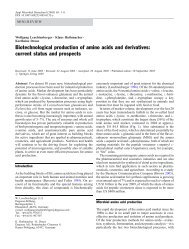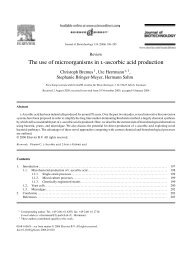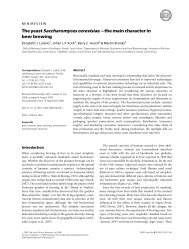The yeast Kluyveromyces marxianus and its ... - It works!
The yeast Kluyveromyces marxianus and its ... - It works!
The yeast Kluyveromyces marxianus and its ... - It works!
Create successful ePaper yourself
Turn your PDF publications into a flip-book with our unique Google optimized e-Paper software.
346 Appl Microbiol Biotechnol (2008) 79:339–354<br />
CCT 3172 in the culture media, which should facilitate the<br />
process to produce pure enzyme (Schwan et al. 1997).<br />
In K. <strong>marxianus</strong>, the pectinolytic enzymes are only<br />
produced during exponential growth, but almost all PG is<br />
secreted in the start of the stationary phase (Schwan <strong>and</strong><br />
Rose 1994; Schwan et al. 1997; Serrat et al. 2004). Among<br />
the cultivation parameters, dissolved oxygen was reported<br />
to be the key in the production of both biomass <strong>and</strong> endo-<br />
PG (Wimborne <strong>and</strong> Rickard 1978; Garcia-Garibay et al.<br />
1987a). High rates <strong>and</strong> yields of biomass production require<br />
high oxygenation levels that, however, repress endo-PG<br />
induction (Wimborne <strong>and</strong> Rickard 1978). <strong>It</strong> was reported<br />
that K. <strong>marxianus</strong> exhibited pectolytic ability when it was<br />
grown without shaking <strong>and</strong> under anaerobic conditions,<br />
<strong>and</strong> no activity was found at high aeration rates (Barnby<br />
et al. 1990; Schwan <strong>and</strong> Rose 1994; García-Garibay<br />
et al. 1987a).<br />
<strong>The</strong> effect of temperature was assessed on both growth<br />
<strong>and</strong> endo-PG production in combination with the effect of<br />
dissolved oxygen (Schwan <strong>and</strong> Rose 1994). Temperature<br />
was also reported to have no direct effect on the synthesis<br />
of this enzyme but influenced the growth rate <strong>and</strong> had an<br />
indirect effect due to changes in oxygen solubility (Cruz-<br />
Guerrero et al. 1999). Addition of pectin in an aerobic<br />
culture in a fermenter was reported to derepress the<br />
production of the enzyme (Garcia-Garibay et al. 1987a).<br />
However, whereas some authors did not find any effect of<br />
pectin addition to the medium in an endo-PG producing<br />
strain (Schwan <strong>and</strong> Rose 1994; Schwan et al. 1997), others<br />
reported the enhancement of pectinase production by this<br />
<strong>yeast</strong> when pectin was added (Wimborne <strong>and</strong> Rickard<br />
1978; Lim et al. 1980; Cruz-Guerrero et al. 1999). K.<br />
<strong>marxianus</strong> CCT 3172 was able to break down pectin but<br />
required a usable source of carbon <strong>and</strong> energy to elaborate<br />
pectinolytic activity (Schwan <strong>and</strong> Rose 1994). <strong>It</strong> had a<br />
strong endo-PG activity between pH 4–6 with pH 5 as<br />
optimum (Schwan et al. 1997). Furthermore, the type of<br />
pectinase excreted by this strain was pointed as a feasible<br />
alternative to fungal production due to the lower broth<br />
viscosity, which can make downstream operations easier<br />
(Almeida et al. 2003a).<br />
Lactose-intolerance can be circumvented by removing<br />
lactose from the diet or by converting this sugar into<br />
glucose <strong>and</strong> galactose with β-D-galactosidase (Rajoka et al.<br />
2003). <strong>It</strong> was reported that only approximately 2% of the<br />
recognized <strong>yeast</strong> species are capable of fermenting lactose<br />
(Barnett et al. 1983), among which strains within the<br />
<strong>Kluyveromyces</strong> genus can be found. In a screening<br />
performed with <strong>yeast</strong> strains belonging to different genera,<br />
only two cultures of K. fragilis <strong>and</strong> Ferrissia fragilis<br />
showed β-galactosidase activity (Fiedurek <strong>and</strong> Szczodrak<br />
1994). Lactose is considered the primary inducer of β-Dgalactosidase<br />
synthesis (Furlan et al. 2000) <strong>and</strong> production<br />
of lactase by K. <strong>marxianus</strong> using cheese whey as a nutrient<br />
source has been investigated by several authors (Sonawat et<br />
al. 1981; Nunes et al. 1993).<br />
During the stationary phase of growth, the β-D-galactosidase<br />
activity of K. <strong>marxianus</strong> CBS 712 <strong>and</strong> CBS 6556 remained<br />
approximately constant (Rech et al. 1999). In contrast, a<br />
reduction of β-D-galactosidase activity was reported by other<br />
authors in the stationary phase (Mahoney et al. 1975). <strong>The</strong><br />
highest β-D-galactosidase activity of K. <strong>marxianus</strong> CBS 712<br />
<strong>and</strong> CBS 6556 was reported to be at 37°C, decreasing quickly<br />
at temperatures above 40°C (Rech et al. 1999), while in K.<br />
<strong>marxianus</strong> IMB3, the enzyme is optimally active at 50°C<br />
(Barron et al. 1995a). On the other h<strong>and</strong>, the β-galactosidase<br />
of K. <strong>marxianus</strong> CBS 6556 is more stable than the<br />
corresponding enzymes of other strains, when stored at low<br />
temperatures, e.g., 4°C (Rech et al. 1999; <strong>It</strong>ohetal.1982;<br />
Brady et al. 1995). When different substrates were investigated<br />
for β-galactosidase production by K. <strong>marxianus</strong>, lactose<br />
supported the highest enzyme activities (Rajoka et al. 2003;<br />
Rajoka et al. 2004).<br />
Inulinase is an enzyme that cleaves fructose molecules<br />
from inulin. <strong>It</strong>s expression is induced by inulin or sucrose,<br />
<strong>and</strong> the enzyme can be excreted to the culture medium or<br />
remain associated to the cell wall (Rouwenhorst et al. 1988;<br />
Barranco-Florido et al. 2001). K. <strong>marxianus</strong> has been<br />
widely studied for inulinase production, aiming at the<br />
production of fructose syrup from inulin (Cruz-Guerrero et<br />
al. 1995).<br />
Pessoa <strong>and</strong> Vitolo (1999) obtained the highest inulinase<br />
activities with the K. <strong>marxianus</strong> DSM 70106 strain, using<br />
inulin as the carbon source. Growth of K. <strong>marxianus</strong> on<br />
sucrose also proceeds via the action of an extracellular<br />
inulinase (Hensing et al. 1994), which is repressed when<br />
growth is not sucrose-limited (Rouwenhorst et al. 1988;<br />
Parekh <strong>and</strong> Margaritis 1985; Grootwassink <strong>and</strong> Hewitt 1983).<br />
K. <strong>marxianus</strong> has also been proposed as a source of: (1)<br />
oligonucleotides, used as flavour enhancers in food products;<br />
(2) oligosaccharides, used as prebiotics; <strong>and</strong> (3)<br />
oligopeptides, immuno stimulators added to dairy products<br />
that are released in the wort after whey protein proteolysis<br />
(Belem et al. 1997; Belem <strong>and</strong> Lee 1998, 1999). Recent<br />
studies have shown the potential of K. <strong>marxianus</strong> FII<br />
510700 biomass as an alternative source to S. cerevisiae for<br />
<strong>yeast</strong> autolysates (Lukondeh et al. 2003a), alkali-insoluble<br />
glucans (Lukondeh et al. 2003c), <strong>and</strong> a natural bioemulsifier<br />
(Lukondeh et al. 2003b).<br />
In the field of bioremediation, processes using K.<br />
<strong>marxianus</strong> were developed for the removal of copper ions<br />
(II) with molasses as a nutrients source (Aksu <strong>and</strong> Dönmez<br />
2000). Lead (II) uptake by K. <strong>marxianus</strong> from contaminated<br />
molasses had negative effects on cell growth. Nevertheless,<br />
the decrease in biomass formation did not lead to decreased<br />
lead (II) uptake; on the contrary, the biosorption ability was





